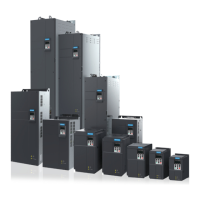8. Peripherals and Options
- 239 -
● Use of CANlink bus
The CANlink bus topology is shown as follows:
CANH
CANL
Set J2 to match
terminal resistor
CGND
CANL
CANH
CANL
CANlink bus
COM
MD500
MD38CAN1
terminal
resistor
CANH
CANL
CGND
MD500
MD38CAN1
CANH
MD500
MD38CAN1
120Ω
terminal
resistor
120Ω
Set J2 to match
terminal resistor
CGND
J2
It is recommended to use an STP cable as the CAN bus and use a twisted cable to
connect CANH and CANL. Connect a matching terminal resistor of 120 Ω respectively
at both ends of the bus to prevent signal reection. The CAN bus allows connection of
a maximum of 64 nodes and the distance of each node branch must be smaller than
0.3 m. Connect the reference ground of all nodes together.
CANH
CANL
COM
Run the twisted cable and cable
connected to COM closely.
CANH
CANL
COM
Connect the shield to COM
CANH
CANL
COM
Twist the other unused cables into
one rope and connect it to COM.
CANH
CANL
COM
Twist the other unused cables into
one rope and connect it to COM.
Connect the shield to PE.
1. Self-prepared single-core cable
2. Twin-core STP cable
3. Multi-core twisted pair cable (non-shielded)
4. Multi-core STP cable
● CANlink Transmission Distance
The transmission distance of the CANlink bus is directly related to the baud rate and
communication cable. The relationship between the maximum transmission distance
of the CANlink bus and the baud rate is shown in the following table.
No. Max. Transmission Distance Baud Rate Number of Nodes Cable Diameter
1 25 m 1 Mbps 64 0.205 mm
2
2 95 m 500 kbps 64 0.34 mm
2
3 560 m 100 kbps 64 0. 5 mm
2
4 1100 m 50 kbps 64 0.75 mm
2

